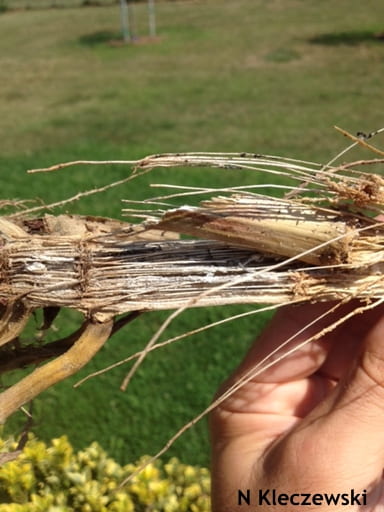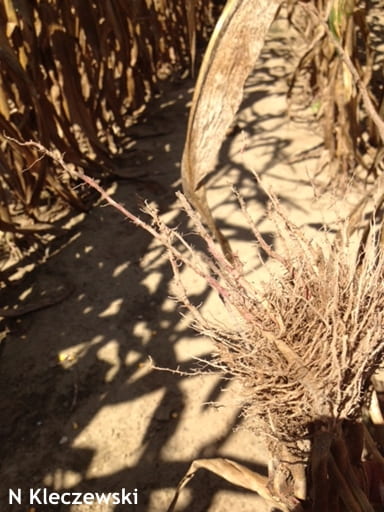Nathan Kleczewski, Extension Specialist – Plant Pathology; nkleczew@udel.edu
Do you have droopy ears (Figure 1)?
Figure 1. Premature senescence and droopy ears are indications of potential stalk rot and standability issues in the future.
Now is the time to scout for stalk rot issues in corn. Scout 1 site per 10-20 acres of field. At each site, push 10-20 plants 30-45 degrees from vertical. If more than 10% of the plants lodge, consider scheduling that field for early harvest. Remember that most issues with stalk rots start with stressed plants. This stress allows many of our stalk or late season root rot fungi to infect and potentially speed up issues with lodging. The best way to manage stalk rots is to minimize stress by planting at optimal populations, managing insect pests and foliar diseases such as grey leaf spot, and using a balanced nutrition program.
We came across the following stalk rot/root rot pathogens on our trips last week.
Charcoal Rot
Look for white to grey macerated tissue in the lower stalk, near the soil like. Black pin head structures often are observed on these tissues. Charcoal rot is often encountered during hot, dry years. In this case, the field was a dryland field under a good deal of drought stress (Figure 2).
Figure 2. Charcoal rot of corn. Note the grey macerated pith and black pinhead structures.
Red Root Rot
I really do not like the name of this disease because it doesn’t really cause a red discoloration, but more of a dark pink/purple discoloration. I suppose, “Dark pink/purple root rot” is not an improvement. You will need to dig up the plant and look at the fine roots to see symptoms of the disease (Figure 3). Reduced root growth or feeder root development may be evident in addition to the discoloration. Red discoloration on the brace roots are not indicative of red root rot, and fungi, such as Fusarium, which are ubiquitous in soils, also can cause a pink discoloration of roots.
Figure 3. Dark pink/purple discoloration of feeder roots indicative or red root rot.



